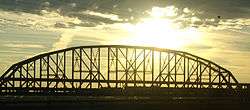MacArthur Bridge (St. Louis)
| MacArthur Bridge | |
|---|---|
.jpg) | |
| Coordinates | 38°36′53″N 90°11′01″W / 38.61472°N 90.18361°W |
| Carries | Terminal Railroad Association of St. Louis, Union Pacific, BNSF, Amtrak |
| Crosses | Mississippi River |
| Locale | St. Louis, Missouri and East St. Louis, Illinois |
| Characteristics | |
| Design | Truss bridge |
| Total length | 18,261 feet (5,566 m) |
| Longest span | 677 feet (206 m) |
| Clearance below | 108 feet (33 m) |
| History | |
| Opened | 1917 |
| Closed | To auto traffic 1981 |
The MacArthur Bridge over the Mississippi River between St. Louis, Missouri and East St. Louis, Illinois is a 677-foot (206 m) long truss bridge. Construction on the bridge was begun in 1909 by the city of St. Louis to break the Terminal Railroad Association of St. Louis's monopoly on the area's railroad traffic. Money ran out before the bridge approaches could be finished, however, and the bridge did not open until 1917, and then only to automobile traffic. Railroad traffic would not use the bridge's lower deck until 1928.
The bridge was initially called the "St. Louis Municipal Bridge" and known popularly as the "Free Bridge." Tolls were added for auto traffic beginning in 1932. In 1942 the bridge was renamed for Douglas MacArthur.
The MacArthur Bridge was one of several bridges in St. Louis which carried U.S. Highway 66 until the completion of the nearby Poplar Street Bridge. At one time U.S. Highway 460 crossed the bridge, terminating on the west side of the bridge. In 1981 the bridge was closed to vehicles because of pavement deterioration and the eastern ramp approaches were torn out. The bridge is now in use only by railroads. The disused vehicle deck has been removed.
By 2007 only about 30% of the total deck reserved for automobile use had been removed. Most of the removed sections were on the East St. Louis side. The western ramp was relinquished to Ralston Purina and turned into a parking lot. In 2013 the TRRA began removing all of the auto deck over the river. By late 2014, the vehicle deck on the bridge proper had been removed, and work was progressing onto the western approach.
In 1989 the Terminal Railroad Association of St. Louis acquired the MacArthur Bridge from the City of St. Louis in exchange for the title to the Eads Bridge. The Eads bridge, one of the primary reasons for the TRRA’s original formation, had become obsolete for modern-day rail traffic due to the height restrictions it placed on rail cars.[1]
The Mac Arthur Bridge continues to be the vital railroad link connecting west to east for a large number of commodities, and bulk cargo.

See also
-
 Bridges portal
Bridges portal -
 Missouri portal
Missouri portal -
 Illinois portal
Illinois portal - List of crossings of the Upper Mississippi River
References
External links
| Wikimedia Commons has media related to MacArthur Bridge (St. Louis). |